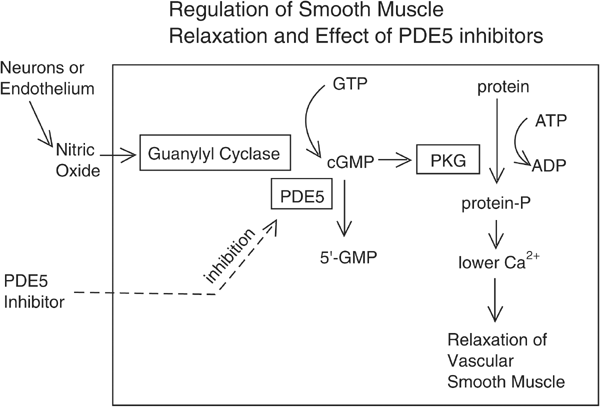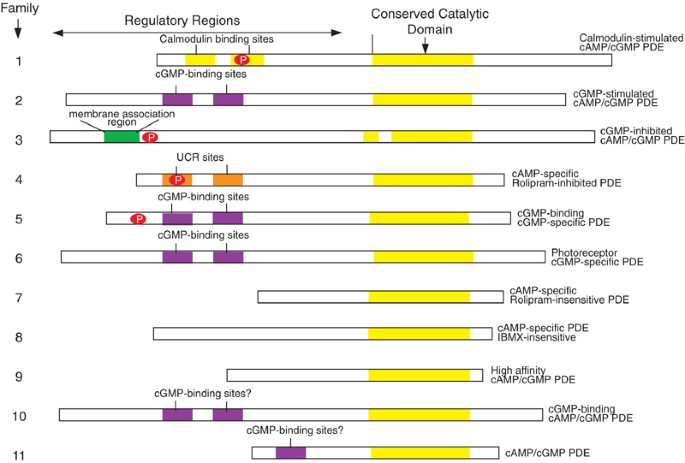In recent years, a deeper understanding of the regulation of penile smooth muscle has led to greater insight into the physiology of normal erectile function and erectile dysfunction (ED) as well as the introduction of phosphodiesterase (PDE) inhibitors for the treatment of ED.
The oral PDE5 inhibitor—sildenafil—has proved to be a safe and effective treatment for this disorder and has fostered further research into the underlying mechanisms of such drugs.
Nitroglycerin, regardless of the dosage form, is converted to nitric oxide (NO) once in the body. It is commonly used in the treatment of angina (chest pain) in patients with underlying ischemic heart disease (IHD).
Since IHD can result in decreased coronary blood perfusion to the heart, the use of nitroglycerin can help vasodilate these vessels to increase coronary perfusion, thereby reducing the severity of angina.
Nitric oxide causes vasodilation through a combination of cellular processes. The first is by activation of guanylate cyclase, which promotes the conversion of guanosine triphosphate (GTP) to cyclic guanosine monophosphate (cGMP).
The increasing cGMP binds to regulatory binding sites for protein kinase G thereby activating the catalytic units that enable protein kinase G to reduce cytosolic Ca2+ levels needed for smooth muscle contraction within blood vessels.1,2 In addition, NO is also known to cause direct activation of Ca2+-dependent K+ channels resulting in a hyperpolarization and relaxation of vascular smooth muscle cells that allow for increased blood flow.

The problem with the co-administration of a type-5 phosphodiesterase (PDE5) inhibitor [i.e., sildenafil (Viagra); tadalafil (Cialis); vardenafil (Levitra)] with a nitrate has to do with their effects on cGMP.
Phosphodiesterase inhibitors are most commonly prescribed for the treatment of erectile dysfunction (ED) and work by selectively blocking PDE5, the enzyme necessary for the degradation of cGMP.
The accumulation of cGMP in the corpus cavernosum of the penis results in the increased vasodilation necessary for an erection.
Therefore when both nitrates and PDE5 inhibitors are administered closely together (within the past 24 hours for sildenafil and vardenafil and within the past 36 hours for tadalafil due to its longer half-life), the PDE5 inhibitor prevents the breakdown of NO mediated increases in cGMP.
This results in a greater effect of cGMP to cause a greater degree of vasodilation. This degree of vasodilation can result in clinically significant reductions in blood pressure or hypotension.
The most prominent example of this interaction is when patients taking PDE5 inhibitors for their ED are given nitrates in the emergency department for acute coronary syndrome with resultant drops in blood pressure.
This problem became significant enough that the American Heart Association published a position statement reminding providers to consider this interaction when using nitrates for this cardiac condition.
This article will review the biochemical pathways involved in erection, the role of PDE5 in these pathways, and the molecular mechanisms involved in PDE activity.
Penile erection results from the relaxation of smooth muscle in the penis. The process is mediated by a spinal reflex and incorporates sensory and mental stimuli.
The balance between factors that stimulate contraction and relaxation determines the tone of penile vasculature and the smooth muscle of the corpus cavernosum.
In primates, including humans, the L-arginine–nitric oxide–guanylyl cyclase–cyclic guanosine monophosphate (cGMP) pathway is the key mechanism of penile erection (Figure 1).
Nitric oxide (NO) is produced from oxygen and L-arginine under the control of nitric oxide synthase (NOS). Sexual arousal stimulates neural pathways that result in the release of NO from nerves and endothelial cells directly into the penis.
NO penetrates into the cytoplasm of smooth muscle cells and binds to guanylyl cyclase. The interaction of NO with guanylyl cyclase causes a conformational change in this enzyme, which results in the catalytic production of 3′-5′–cyclic guanosine monophosphate from guanosine 5′-triphosphate. Cyclic GMP is the intracellular trigger for penile erection. Cyclic GMP activates cGMP-dependent protein kinase (PKG), which in turn phosphorylates several proteins.
These protein kinase interactions result in reduced intracellular calcium levels and a consequent relaxation of arterial and trabecular smooth muscle, leading to arterial dilatation, venous constriction, and the rigidity of penile erection.

Nitric oxide–cGMP pathway for relaxation of smooth muscle.
Since cGMP plays a key role in this process, potential interventions for inadequate smooth muscle relaxation include increasing the level of intracellular cGMP. PDE5 normally inhibits penile erection by degrading cGMP. This degradation occurs at the catalytic site in the presence of bound zinc.
PDE5 inhibitors lower the activity of PDE5 by competing with cGMP and consequently raise the level of cGMP. In the absence of stimulation of the NO pathway, PDE5 inhibition is ineffective.
In isolated strips of corpus cavernosum, sildenafil relaxes the smooth muscle by amplifying the effects of the normal, endogenous cGMP-dependent relaxation mechanisms but produces little effect in the absence of a NO donor.
Since sexual arousal stimulates this pathway specifically in the penis, PDE5 inhibitors have a relatively small effect on smooth muscle in other tissues.
PDE5 is the predominant phosphodiesterase in the corpus cavernosum. However, at least 11 families of PDE have been identified in mammals (Figure 2, Table 1).
Some PDE types are associated with more than one gene and some mRNAs exhibit two or more splice variants; the result is more than 50 species of PDE. Some types of PDE are specific for either cyclic adenosine monophosphate (cAMP) or cGMP, and some degrade both. PDE11, for example, degrades both cAMP and cGMP, whereas PDE4 is specific for cAMP, and PDE5 is specific for cGMP. The crossreactivity of PDE inhibitors can be attributed largely to similarities of their homologous catalytic domain.
Messenger RNA has been detected in human corpus cavernosum tissue for the human PDE isoforms—_PDE1A, PDE1B, PDE1C, PDE2A, PDE3A, PDE4A, PDE4B, PDE4C, PDE4D, PDE5A, PDE7A, PDE8A, and PDE9A.
Most mammalian PDEs are dimers, but the functional significance of this dimerization is unknown. Some, like PDE5, have two identical subunits (homodimers), and some, like PDE6, have two different subunits (heterodimers).

Phosphodiesterase families.
The PDEs also differ in the nature of the regulatory domain of the enzyme and in the role of phosphorylation. In all cases, the catalytic domain is located toward the carboxyl terminus, and the regulatory domain is located toward the amino terminus.
A PDE5 monomeric fragment retains the essential catalytic features of the dimeric, full-length enzyme. The regulatory domains differ among subtypes. For example, in PDE1, calcium binding regulates the enzyme. Phosphorylation is important for some, including PDE5.
Some have one or more GAF domains, which bind cGMP in PDE5 and thus represent allosteric (noncatalytic) sites. In addition to its cGMP-selective catalytic site, PDE5 contains two potential allosteric cGMP-binding sites and at least one phosphorylation site for PKG on each subunit.
cGMP can bind to allosteric binding sites of PDE5, and cGMP occupation of one or both of these sites stimulates the catalytic site for cGMP. Occupation of the allosteric binding site by cGMP alters the conformation of PDE5, which exposes a phosphorylation site (serine-92 in the bovine enzyme, serine-102 in the human enzyme).
Phosphorylation of PDE5 by protein kinase G (PKG) augments the enzymatic activity as well as the affinity of PDE5 allosteric sites for cGMP.14,15 The level of enzymatic activity has been shown to increase in parallel with phosphorylation, and the increase in activity is typically about 1.6-fold.

PDE5 structure.
In rat aorta and human smooth muscle cells, activation of PKG by 8-Br-cGMP leads to phosphorylation and activation of PDE5, whereas 8-Br-cAMP has no effect. This represents negative feedback control in smooth muscle cells, since elevation of cGMP stimulates cGMP degradation. Blockade of this negative feedback mechanism by occupation of the catalytic site is partly responsible for the effect of PDE5 inhibitors on penile erection.
Since they raise the level of cGMP, PDE5 inhibitors potentiate their own actions since cGMP binding to the allosteric site stimulates further PDE5 inhibitor binding to the catalytic site. Each PDE5 inhibitor is thought to exhibit the same mechanism, but this has not been established.
Several negative feedback mechanisms come into play to lower the level of cGMP when it is elevated. Increased degradation occurs simply by mass action effect (ie, increased substrate availability for PDE5.)
Also, PKG phosphorylates PDE5, causing its activation. This results in even greater degradation of cGMP. Phosphorylation also increases PDE5 allosteric site binding of cGMP, which makes less cGMP available for activating PKG.
Finally, increased binding of cGMP to the allosteric site stimulates cGMP degradation by the catalytic site of PDE5 and further increases phosphorylation of this enzyme.
In conclusion, specific molecular and pharmacologic properties endow individual PDE5 inhibitors with unique characteristics. Owing to these distinctions, selective PDE5 inhibitors hold promise for innovative pharmacologic applications.
